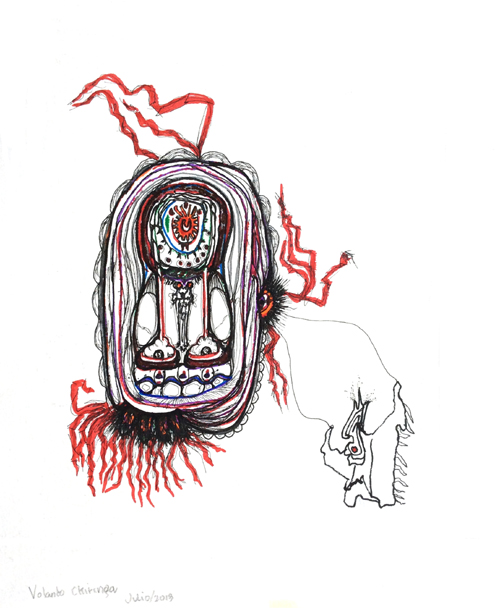
20 July – 24 September, 2017 Room 5. First Floor
Frances del Valle was a student of Eugenio Fernández Granell in the 1950’s at the University of Puerto Rico (UPR), where Granell taught art courses. In her last year at the university Frances cofounded the surrealist group Mirador Azul. Reflecting on the group she says: “we were lizards in a place where people found them repellent.” Now in her eighties she continues to work because “there is much left to be done.” Frances’ work was presented for the first time in 1956 in a landmark collective exhibition at the UPR, where Granell and other established artists were also represented. Since then she has participated in many collective and individual exhibitions. In the 1970s Frances cofounded the puppet workshop Teatro Pacholí with artist and educator Anita Campos, staging plays for kids in localities with few resources. In the 1980s she was a member of the collective Arte en la Calle, an artists' group sharing the vision [conviction] that art is for all, and not just for those in museums and galleries. Frances has contributed work to support efforts for the independence of Puerto Rico, women’s rights, and environmental struggles. Her most recent exhibitions are: Pajarera (2001), En Tinta Viva (2003) and Veo, Veo (2011).
The director of the Fundación Eugenio Granell, Natalia Fernández Segarra, suggested to FDV an exhibition of her recent works that had not been shown before. In this exhibition, the director has found remarkable ways to tie her artwork together, given that FDV’s work is not structured by themes although it is undeniably permeated by recurring ideas. The works are mixed media, collage, recycled materials and drawings on paper where the artist fuses myths and legends, films, science fiction stories, Persian and Indian miniatures, news and family events: “whatever it can withstand.” FDV says that “in my internal world as in a dream, my version of the external is hatched.”
Most of the work in the exhibition was generated in the last ten years, but a few are older. They provide a sense of the transitions in the work of the artist, between the new and the repetitive. For example, the 1995 ink drawing Guerrera presents one of FDV’s favorite characters – the woman as an entity determining life and death. The feminine is presented as point of origin: island, jewel, moon, egg, hole, cave, eye, star, and universe. It also appears as harpy, fury, queen, Eve. The goddesses Astarte, Ishtar, Venus, Oshun, Yemaya, Guabancex, and all the virgins are presented not because they are symbols, but because they are women, and as such FDV identifies herself with them. She says that when faced with male supremacy, through these goddesses women are unquestionably the power, not appendages.
Other characters can be found in her work. For example, the vejigantes – mischievous spirits of the Puerto Rican folklore, and trees for their powerful vitality. She is also inspired by the ancient Antillean belief that the Ceiba tree is the link between life and death, and its canopy is inhabited by other spirits.
Of her method of creation she says that it is what comes out, as it appears, with the medium that she wants, or that she has at hand. If she is not satisfied with the work, it is thrown out. For FDV experimentation is necessary. She enjoys working with tiny details. The collage technique kindles her imagination, and leads her to find new forms. She does not follow a rational process. FDV says the imagination cannot be reduced to a method. She can be meticulous or not, as she deems. Some pieces require more control and a deliberate effort. Volando chiringa – in Puerto Rico chiringa is the word for kite, exemplifies work created with total freedom, where the image arises as it is being created. The dimensions of the works are a reflection of available work space and resources.
While FDV’s work is not disengaged from the world, it does not seek to represent it. If the observer finds any references, they are welcomed. A drawing suggests and provides the space for the spectator’s interpretation. It is a dialogue that is not expressed in words, but that happens precisely at the moment of the encounter.
This exhibit presents a selection of FDV’s work to an international audience for the first time. The artist wants to know what is said about it, what interpretations it prompts, and how it relates with what is happening outside her orbit. The artist and her work await commentary.







